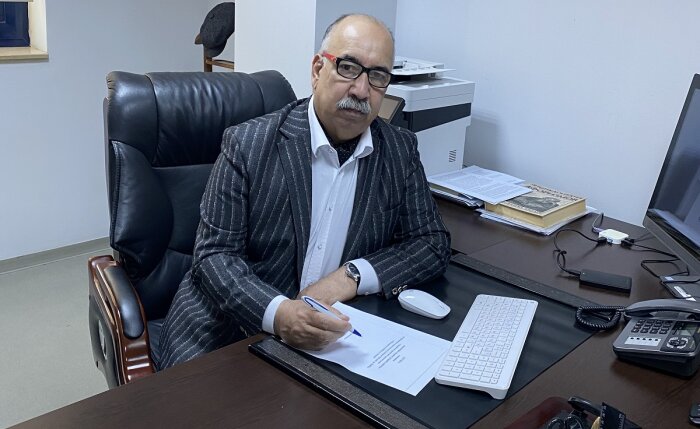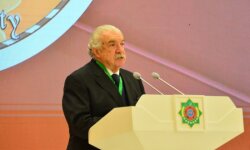 Currently, the efficient use of water resources is a pressing challenge facing humanity. Taking care of water resources is a priority area of activity of the international community. The UN designated March 22 as the World Water Day in 1993. Doctor of Technical Sciences Allaberdy Ilyasov shared the key aspects of Turkmenistan’s water strategy with the readers of CentralAsia.news.
Currently, the efficient use of water resources is a pressing challenge facing humanity. Taking care of water resources is a priority area of activity of the international community. The UN designated March 22 as the World Water Day in 1993. Doctor of Technical Sciences Allaberdy Ilyasov shared the key aspects of Turkmenistan’s water strategy with the readers of CentralAsia.news.
‘Green’ shield of water bodies of Turkmenistan
The total water capacity of Turkmenistan, used by economic sectors, is composed of the surface runoff of the rivers Amudarya, Murghab, Tejen, Atrek, Sumbar and Chandyr, as well as small watercourses of the north-eastern slopes of the Kopetdag Mountains and the Koytendag Mountains, springs and small volumes of groundwater and drainage waters. The promising sources of preservation and replenishment of freshwater reserves include the plantations of deciduous trees along rivers and canals, the roots of which retain more than 50 percent of water filtration, and the leaves and tree crowns of these trees have a beneficial effect on the mild climatic temperature condition of the atmosphere.
Furthermore, tree plantations along watercourses help restore landscapes and balance in nature suffering from extreme conditions, while protecting local settlements from the effects of climate change. Thus, the grids of water-conservation plantations help prevent uncontrolled runoff of diffused surface waters and serve as a natural barrier to prevent mineral fertilizer residues from penetrating into waters from fields. Currently, the country is intensively developing agriculture, and trees play an important role in consolidating the banks. Forests retain melt and storm runoff; a ‘green’ shield is therefore important for optimising, preserving and improving the hydrological regime and underground feeding of rivers.
Water policy of Turkmenistan
The socio-economic strategy of Turkmenistan attaches special importance to the efficient use of water resources. The development of economic sectors and population growth entail increasing water demand in the future. The country takes constructive measures to conserve and improve water quality and modernise the legal framework on water use and protection. The prospects of environmentally sustainable development of Turkmenistan involve ensuring sustainable growth of water supply systems in all the regions.
Turkmenistan’s water sector, as a resource-providing industry, is one of the cornerstones on the innovative path of economic development. The national water sector development strategy is particularly aimed at protecting and efficiently using water resources, developing and adopting water-saving technologies and techniques. The Water Code of Turkmenistan is the strategic document. This legal document highlights the importance of water resources and focuses on protecting water from pollution, contamination and depletion, preventing and mitigating adverse impacts, restoring and improving the condition of water bodies.
The strategic goal of Turkmenistan’s water policy is to maintain sustainable and economically sound water use. This allows meeting the demand of the population and manufacturing sector for water of the required quality, restoring the natural or close to the natural state of water bodies, exercising the rights to water and a healthy environment. One of the main objectives of Turkmenistan’s water diplomacy is to initiate of a universal political and legal document — the UN Water Strategy at the global level that sets forth the goals, approaches and actions of the international community towards the long-term conservation and use of water resources on the planet.
Turkmenistan supports the solutions to all emerging regional water and energy problems based on the three principles: universally recognized norms of international law, respect for the interests of each country and the engagement of international organisations, particularly the UN. Turkmenistan promotes a balanced approach among Member States to the coordination and efficient use of water resources. Official Ashgabat invited UN Member States to develop a Water Strategy for Central Asia.
Water diplomacy of Turkmenistan
The ratification by our country of the UN environmental conventions on biological diversity, desertification control, climate change, the protection of the ozone layer and the protection and use of transboundary watercourses and international lakes vividly illustrates Turkmenistan’s proactive approach to addressing global environmental issues. Turkmenistan is implementing dozens of programmes and projects in these areas jointly with the authoritative international organisations at the national and regional levels.
Long-term cooperation between Turkmenistan and the Caspian states has resulted in developing common key principles of policy in the Caspian Sea Region. They adopted the main document — the Convention on the Legal Status of the Caspian Sea. All the participants of the Sixth Caspian Summit, which took place in Turkmenistan, firmly confirmed their readiness to closely cooperate on environmental issues. This opens up ample opportunities to launch broad and systematic interaction between the Caspian states and the UN.
In this context, the proposal was put forward to develop the Caspian Environmental Initiative, designed to provide an international platform for substantive and professional partnerships on a wide array of environmental issues, including protection and conservation of biodiversity of the Caspian Sea and the solutions to pressing environmental problems.
Currently, Turkmenistan under the far-sighted leadership of President Serdar Berdimuhamedov is taking comprehensive measures to protect the environment and ensure the effective management of natural resources through adopting cutting-edge environmental technologies. Thus, Turkmenistan takes a very responsible approach to coordinating international efforts to address pressing environmental challenges facing humanity and makes a worthy contribution to this work.



